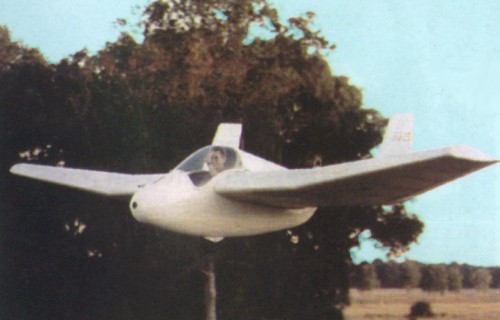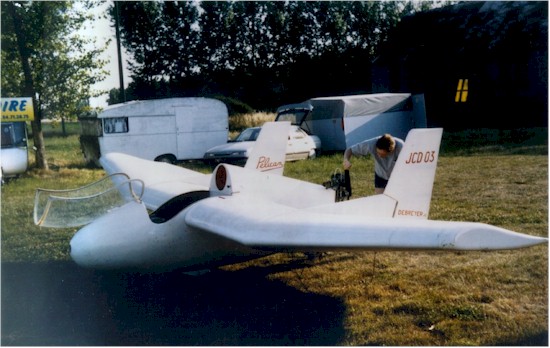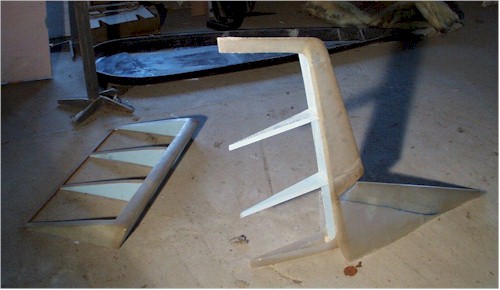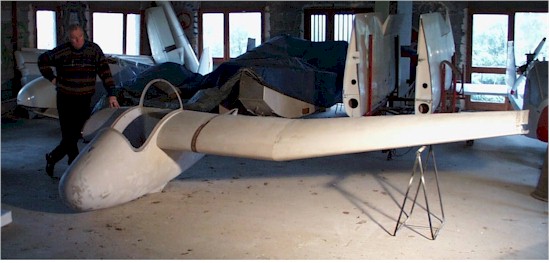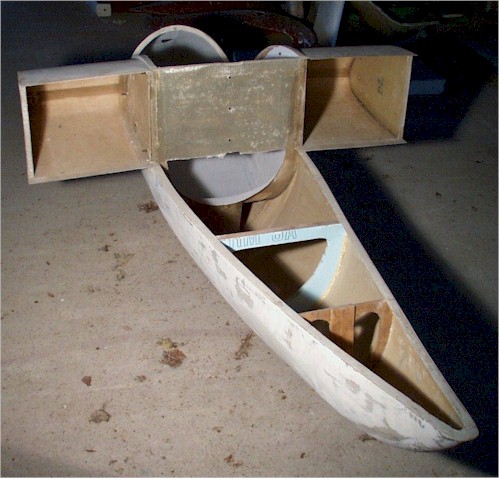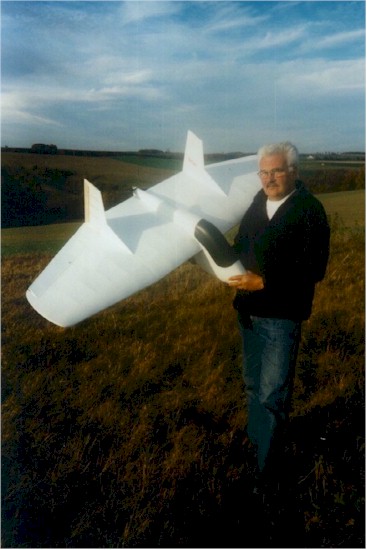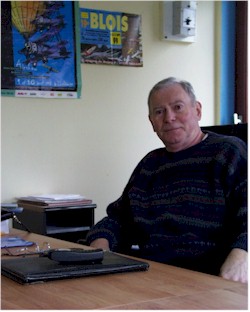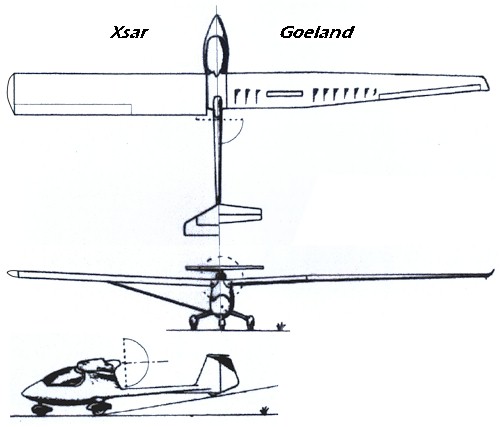| The 11th mars 2000 I got a unique opportunity. I was invited by Michel Mangenot of Air Est Services, the manufacturer of the Pelican, a remarkable flying wing. Whenever you see this Pelican you will say: "Man, it
is small !". |
Other products of |
||||||||||||||||||||||||||||||||||||||||||||||||||||||||||||||||||||||||||||||||
|
|||||||||||||||||||||||||||||||||||||||||||||||||||||||||||||||||||||||||||||||||
|
|||||||||||||||||||||||||||||||||||||||||||||||||||||||||||||||||||||||||||||||||
| I looks a
bit like a Fauvel (but all unswept flying wings do, especially those with two rudders),
but it not a motorized glider. It is a ultralight according to the French regulations.
Probably according to many other countries regulations too. What was the main goal of the designer of the Pelican, J.C. Debreyer? He wanted to prove that you can fly with only 10 HP. And he did prove it. During my talk with Michel Mangenot I asked him if you needed to be a experienced pilot to fly the Pelican. "On the contrary", he said, "it is a ideal plane for a beginner with limited resources (= money). It is cheap and stable enough for a beginner." When he said cheap I had no problem to believe. The next picture shows one of the rudders and the elevator in construction. Do you see the blue foam?
|
|||||||||||||||||||||||||||||||||||||||||||||||||||||||||||||||||||||||||||||||||
On the background you see the bottom of a project (black rain drop shaped plate), which Michel Mangenot did help. It is a part of a car that did "race" in a competition where cars have to ride as far as possible with ONE liter (0.26 US gallon) fuel. This team of students made a good race. Mangenot did advise them in the use of composites and did help to construct the cars body.
|
|||||||||||||||||||||||||||||||||||||||||||||||||||||||||||||||||||||||||||||||||
| Did you
recognize the foam? Yes, it is the blue isolation foam you can buy in any local DIY
(translation DIY: doe-het-zelf-winkel (NL), ........................). The low
wing loading
allows the use of this foam in the construction of ribs of the wings and rudders.
|
|||||||||||||||||||||||||||||||||||||||||||||||||||||||||||||||||||||||||||||||||
|
|||||||||||||||||||||||||||||||||||||||||||||||||||||||||||||||||||||||||||||||||
| The first
Pelican was made in one piece. Christophe Bordeaux has some nice pictures of the Prototype
in his site (section Fauvel of the Nurflugel-site). The prototype can be recognized by its
"squared" cockpit which was made in wood. Michel Mangenot is currently working
on a Pelican with detachable wings. There are still some things that need to be worked
out. But I started thinking: "Are detachable wings necessary?" All the classic
sport planes like Piper, Cessna, Robin don't have detachable wings. They are delivered to
your airstrip and then you stock them in your hangar. Why wouldn't you buy a Pelican if
you have a hangar (your own or the clubs) to place it in on your local airstrip. One-piece
airplanes are easier to build, are lighter (no heavy connection points) and you don't have
the fuss with connecting cables or rods. The problem of getting it to your airstrip is
only a one-time-event. I am sure that moving companies can be a easy solution for this
event.
|
|||||||||||||||||||||||||||||||||||||||||||||||||||||||||||||||||||||||||||||||||
|
|||||||||||||||||||||||||||||||||||||||||||||||||||||||||||||||||||||||||||||||||
|
|||||||||||||||||||||||||||||||||||||||||||||||||||||||||||||||||||||||||||||||||
|
|||||||||||||||||||||||||||||||||||||||||||||||||||||||||||||||||||||||||||||||||
| You can
buy the Pelican as a kit. The kit includes all the fiberglass parts and the plans to
finish the kit. If you like to know the price of the kit contact Michel Mangenot at air.est.services@wanadoo.fr (use "Price
kit Pelican" as subject for your e-mail). Another airplane I saw was the Goeland. Although it is motorized glider with a conventional layout I was happy to see it. It has something remarkable. Best way to describe it is "one fuselage = several airplanes". Let me explain. Michel Mangenot did buy a old Fauconnette-glider. He uses the old wings on a newly designed fuselage which can carry a engine. Together they make the Goeland. This way of working is according to Mangenot a very cheap way of getting yourself a motorized glider. There are still enough secondhand Fauconnettes. Mangenot did already draw the new wing which should replace the Fauconnette-wing if the secondhand would get expensive due to a disappearing stock. The new wing would use a modern airfoil and this would lead to a shorter span. This wing is still not available. The Goeland has evolved since its birth (currently edition # 8) . It has a larger rudder surface. The wing is no longer placed with struts on top of the fuselage. The wing is now connected directly to the fuselage. You can choose one of the two landing gear configurations for this motorized glider. Trigear (a nosewheel and two wheels in the back) or a central placed single wheel. The Xsar is created by using the Goeland fuselage and some specific ultralight-wings. These wings are rectangular and supported by struts.
|
|||||||||||||||||||||||||||||||||||||||||||||||||||||||||||||||||||||||||||||||||
|
|||||||||||||||||||||||||||||||||||||||||||||||||||||||||||||||||||||||||||||||||
| I did found this idea very interesting. The use of secondhand wings to create a new airplane is something new to me. I like the idea. It could give you a cheaper airplane. Like I said ... the man has a vision! Michel Mangenot is also producing some car parts. I saw some huge airscoop which can be placed on American cars with double carburetors. There were also a set of wheelfenders for those who want to place two wheels on each side of the back-axle of their puck-up. You can visit the atelier in the small village Ancy-sur-Mocelle in France. Ancy-sur-Mocelle is too small to be placed on a map (it wasn't on my map anyway), but you can reach it by driving along the highway from Metz to Nancy, taking the exit Moulins-sur-Mocelle, then ride towards Ars-sur-Mocelle. Ars-sur-Mocelle is the village next to Ancy-sur-Mocelle and can be found on a map. Michel Mangenot will give you further instructions how to get to his atelier. Michel Mangenot is able to read English, but he will respond in French (be sure to mention if you can read French or not) or will send you a standard letter in English with all current data. |
|||||||||||||||||||||||||||||||||||||||||||||||||||||||||||||||||||||||||||||||||
